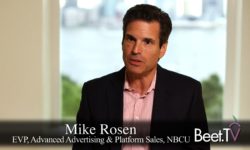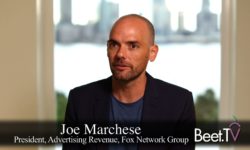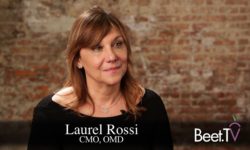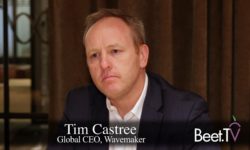Like some people with a long background in media, Janet Balis tries to parse the semantical nuances of what constitutes “advanced advertising,” particularly when the term is applied to television. What’s more important right now is that the sell-side and buy-side come together to craft uniform audience targeting and measurement solutions, says EY’s Global Advisory Lead, Media & Entertainment.
In this interview with Beet.TV, Balis talks about why targeting is more of an immediate concern than achieving true one-to-one TV addressability at scale, and how EY counsels its publisher clients on the various ways they can better control and monetize their businesses.
“Television still very much matters,” is how Balis prefaces her comments about advanced targeting, before questioning its oft-malleable definition. “If we’re talking about truly addressable, having a full, two-way footprint, we’re a ways off from that being at scale. So I tend not to think as much about advanced advertising,” Balis says.
She’d rather concentrate on the confluence of digital advertising media and the growing number of TV delivery options, whether it’s video on demand or over-the-top streams. “There’s no question that we’re moving to more advanced television advertising. But the crux of what’s happening right now is much more about targeting,” particularly audience segmentation.
“And right now, what you see is essentially every network or network group has their own approach to how they bring more optimization into the mix.”
Today’s world is one in which an industry that for years was based on programs and ratings is colliding with one centered on viewable impressions “in a very different kind of content.” However, “there’s no comparability of the currency.”
This why media buyers and sellers, people “who would traditionally look at each other as competitors,” should come together around new standards and ways to transact. “Because but for an industry solution, it’s very hard to see how we will really get to scale.”
The beneficiaries will be marketers that want to be able to use the same audience segment “across different places, compete viably in the marketplace and really understand the value that they’re getting out of advertising. That’s the pressure around where television advertising is going today.”
For publishers working to monetize their content, Balis believes the biggest pressure is “first and foremost to market themselves differently” while taking control of how they acquire customers and achieve distribution.
Adopting a more direct-to-consumer approach is in contrast to publishers’ “dependencies on many of the largest players in that landscape.”
Balis describes digital display ads as being at “a very mature, plateauing perhaps declining, side of the marketplace” given alternative formats—video being at the top of the list.
“With that being the case, we really have to look at subscriptions, the value exchange that we have with consumers, how we look at compensating transparently for the use of data and what that value exchange that enables consumers to want to provide their data.”
This video is part of The Road to Cannes, a preview of topics to be addressed at Cannes Lions. The series is presented by the FreeWheel Council for Premium Video. For more videos from the series, please visit this page. FreeWheel is a Comcast company.
















![New true[X] President Midha Looking To Leverage The ‘Connected Living Room’](https://www.beet.tv/wp-content/uploads/2018/05/pooja-midha-thumbnail-1-250x150.png)

![[m]PLATFORM’s Hanlon Contemplates The Utility Of Data, Personalized Creative](https://www.beet.tv/wp-content/uploads/2018/05/thumbnail-102-250x150.jpg)




![Television Advances As Consumers Choose Interactive Advertising, true[X] Midha explains](https://www.beet.tv/wp-content/uploads/2018/05/pooja-midha2-thumbnail-250x150.png)






















